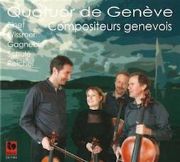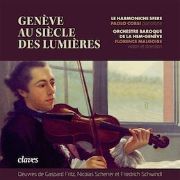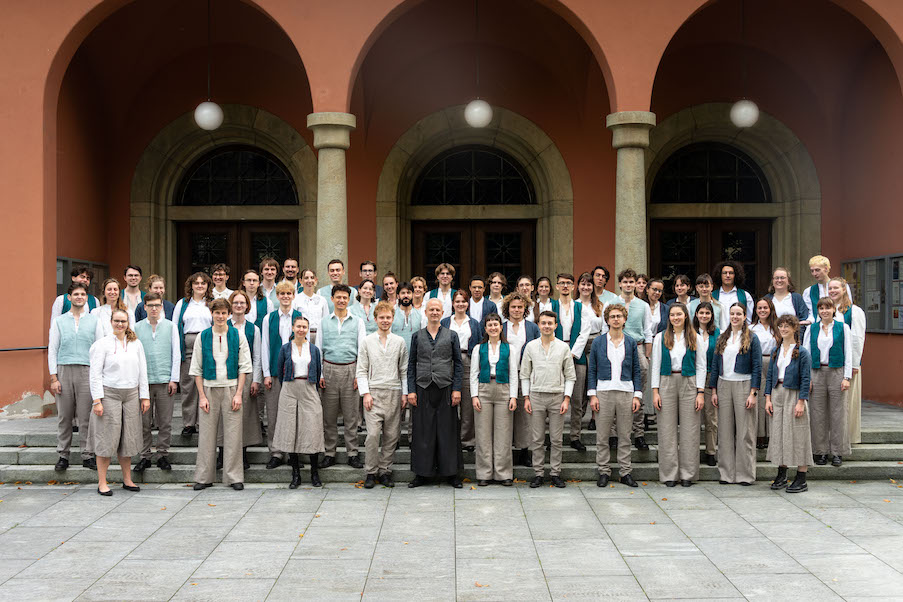Genevan music through the centuries
What discoveries! Five quartets by 20th-century Geneva composers (Wissmer, Binet, Schulé, Gagnebin and Reichel), followed by music from the Age of Enlightenment (Gaspard Fritz, Friedrich Schwindl and Nicolas Scherrer).

It's a wonderful initiative to introduce us to little-known pages written by composers of the 20th century.e century that have remained too confidential.
Genevan composers? Is there a common element, apart from provenance? Calvinist austerity? Not necessarily. Sometimes, a little, all the same: despite the era, we wisely remain in the tonal or modal expanded and measured. The Geneva quartet traverses these pages with impeccable intonation. François Payet-Labonne and Sidonie Bougamont (violins), Emmanuel Morel (viola) and André Wanders (cello) offer us a wide palette of colors in a program that begins with the quartet by Jean Binet (1893-1960). This is a work written with great skill. It reveals a fine sense of development, originality and personality.
Pierre Wissmer (1915-1992) writes his 2e quartet with an eye for sonic refinement. While remaining formally within a very classical mold, the piece moves within a very broad and perfectly mastered tonal system.
With the 2e quartet Divertimento by Henri Gagnebin (1886-1977), we return to a relatively more classical harmonic world. The combined influence of Debussy and Ravel is clearly evident. Written in four movements, the work reveals a fine sense of melody. A pleasant and endearing piece of music.
It is difficult to find unity in the five movements that make up the Romantic celebration by Bernard Schulé (1909-1996). His quartet could be film music, a genre in which the composer often dabbled. We move from one scene to another, from a rural setting to an unrelated fugue. The composer's personality is best revealed in 2.e movement quasi improvvisataas well as in the charming popular quotations of the 3e part.
The title of these three preludes and ricercari by Bernard Reichel (1901-1992) sets the tone. The gentle rhythmic sway of the preludes lulls us into a dreamy state, sustained by the performers' beautiful half-tones. Each prelude is followed by a ricercare in which the reference to the ancients is obvious. Fortunately, however, this is not the neo-classicism fashionable at the time among certain composers in search of new ideas: there is real inspiration here. The Geneva quartet reinforces the ancient reference by its vibrato-free playing.
The strength of this recording lies above all in the fact that the musicians manage, with great dedication, to change their style and sound to suit each page. Intelligent, sensitive interpretations. What more could you ask for?
Quatuor de Genève: Composers from Geneva (Binet, Wissmer, Gagnebin, Schulé, Reichel). Gallo CD 1463
Curious music lovers may have heard of Wissmer, Binet, Schulé, Gagnebin and Reichel, but I defy them to sing a melodic line by Gaspard Fritz, Friedrich Schwindl or Nicolas Scherrer! With this double-album, we're off into the great unknown. Sometimes you might think that if a composer from previous centuries has been forgotten, it's because his music wasn't of sufficient interest. Not so with this recording!
It's a real pleasure to listen to this refined, gallant but never superficial music. All the more so as the performers articulate their discourse with remarkable acuity. Led from the violin by Florence Malgoire, the Geneva HEM Baroque Orchestra is made up of professional students who believe in what they do. The balance between strings and wind is ideal, bringing out every stratum of the sound architecture. It's both clear and perfectly homogeneous. Ideal conditions for discovering the beautiful symphonic pages of Gaspard Fritz (1716-1783) and Friedrich Schwindl (1737-1786).
The second CD is devoted to chamber music by the above-mentioned composers, plus Nicolas Scherrer (1747-1821). The members of the "Le Harmoniche Sfere" ensemble bring their in-depth knowledge of this repertoire to bear on their luminous musicality. Denitsa Kasakova's lyrical violin always tells a story, supported by the ductile touch of Paolo Corsi's fortepiano, played on a magnificent instrument by Johann Andreas Stein (1782). The shimmer of Esmé de Vries's cello is an added bonus. Thanks to their perfect complicity, but also to the excellence of the sound recording, one never has the impression of a solo instrument pulling the cover, accompanied in the shadows by instruments in the background. That's rare enough to be worth noting!
(This recording accompanies the book "Musiciens et amateurs" by Corinne Walker, published by La Baconnière/Arts, cf. review in RMS 4/2018, p. 16.)
Geneva in the Age of Enlightenment. Florence Malgoire, Violin and Conductor; Geneva HEM Baroque Orchestra; Paolo Corsi, Pianoforte; Le Harmoniche Sfere. Claves Rarities 50-1610/11 (2 cd)








